This article will examine trends in San Diego home price levels, breadth, sales volume, and inventory in order to determine where the undercurrents are taking the market. Additionally we will take a look at a warning light that has started to flash for the local economy.
Prices
Nothing too dramatic happened in the price department. After bouncing down last month, they bounced back up this month:
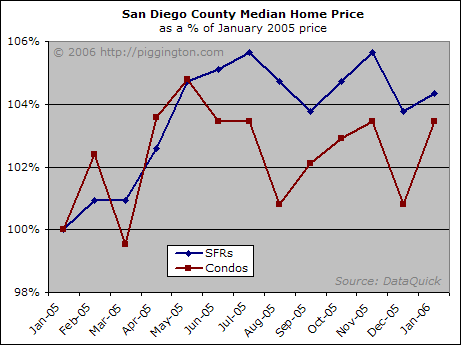
One reader asked in an article comment how prices could have risen last month when we hear so much about longer times on the market, lowered asking prices, rising inventory, etc. It’s a good question, and I had a few thoughts.
First, prices are down in some areas, and up in others. The countywide median does not really reflect those specific areas where prices are down by a notable amount. The breadth figures I look at each month show a very clear trend towards a declining number of areas with year-over-year increases, and, more importantly, an increasing number of areas with significant year-over-year declines. Per the second graph below, 1/3 of all San Diego zip codes now have median condo prices that are at least 5% below what they were one year prior.
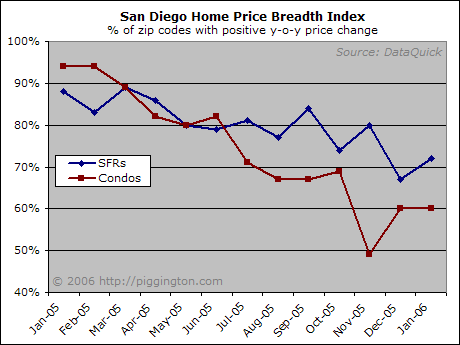
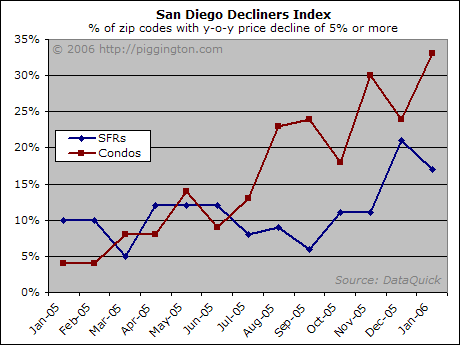
So there are losses out there, and plenty of stories of declining home prices. But that fact may not show up in the countywide median, which is why I look at individual areas as a leading indicator for what will happen countywide.
Another reason that the median may be doing well is that the amount of concessions have really risen over the past year. The car giveaways, the builder enhancements, the paying of closing costs—none of these are reflected in the reported sale price, but each concession does reduce the effective price paid. So as more and more incentives are thrown in, the median price will continue to overstate what people are paying, although I obviously can’t tell you exactly how much of an effect this is having.
A few readers chimed in with ideas as well. The original questioner herself found some RE agent commentary stating that volume had dropped within the lower price ranges, which would of course skew the median higher. This certainly makes sense. And another reader pointed out that builders are often releasing big McMansion subdivisions all at once, which could tend to spike prices northward.
I think that all of the above factors are at work. But most importantly, I think it’s not useful to get too bogged down in what happens in a single month. The real estate market is massive and slow moving, and there are so many factors that could throw off the median (such as concessions and size/quality/age of the homes being bought) that the median price is really a very blunt analysis tool. It’s much more important to look for trends in the median price, and to look for clues in the other indicators included in this report each month, than to read too far into a one-month drop or rise.
That said, let’s look at those other indicators…
Volume
Sales volume was just terrible. SFRs hung in there a lot better, as has been the trend, but condo sales were down a whopping 35% from a year ago.
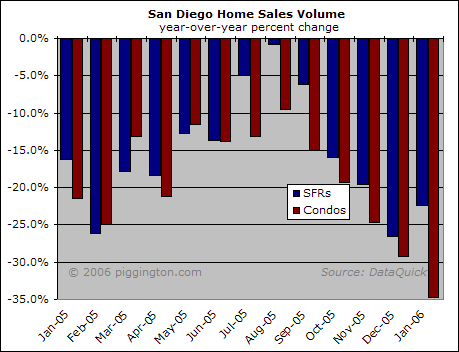
Volume has been on a fast track to nowhere since June:
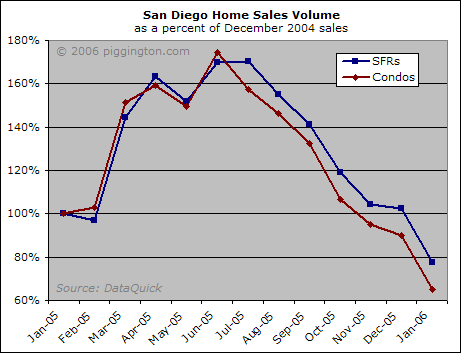
There is of course a seasonal component to the latter graph, but the first graph (which abstracts out seasonality by comparing to the same month in the prior year) shows that volume is extremely weak no matter how you slice it.
Inventory
Unfortunately, this weak demand is combining with a seemingly endless onslaught of new supply. After the winter dip, people are back putting their homes on the market with a vengeance:
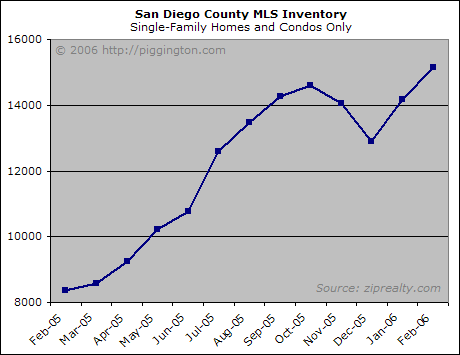

The burgeoning glut continues to grow—a fact that is entirely ignored by the "housing shortage" crowd (not that they were ever big fans of looking at facts).
|
Property Type
|
Months of Inventory
|
|
SFR, SD County
|
7.4
|
|
Condo, SD County
|
9.5
|
|
Condo, Downtown SD
|
17.3
|
(Please note that I was able to attain new data to calculate the "months of inventory" figure… hence any differences from last month. This data will give a more up-to-date perspective on inventory and will be used from here on out).
Defaults
The number of homeowner notices of default (sent to homeowners who haven’t been paying their mortgages) has grown quite dramatically over the past few months:
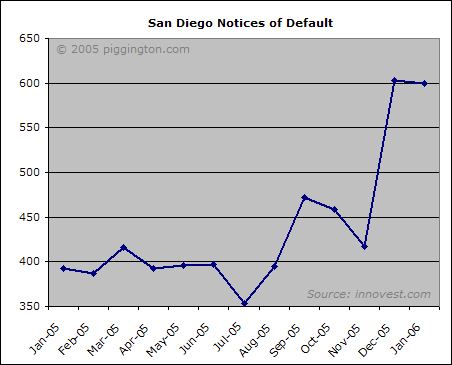
This is an important warning sign. I have long maintained that no real pain will be felt in the housing market until a substantial number of people are forced to sell. Notices of default are a great indicator of how many people are in the bad kind of financial situation that results in must-sell inventory.
The number of NODs is still nice and low historically. But it’s up by 50% in the past 6 months. We’ve always known this day would come: when exotic loans start to reset for people who bought since the market started flattening (and thus have no equity cushion), many if not most will have to bail. With a lot of loan resets due in 2006 this is clearly starting to happen. I expect the number of homeowners in default to skyrocket, so while the numbers are still small this is an important trend to watch.
Conclusion
There’s no change to the big picture. The bubble is already deflating, but very, very slowly. This will speed up at some point, but for now the market remains in "slow motion trainwreck" phase.
The early months are always tough to read because of seasonality —we will get a much clearer picture in the spring. But the market doesn’t seem poised for much of a springtime rally. Rates are rising, inventory is growing, sales are weak, and many areas of San Diego are already seeing year-over-year price declines. Whatever strength does show in the spring may be very short-lived. We will have to take a fair and balanced look at the data that comes in, but until proven otherwise, it looks like the long-term direction of the market is clearly "down."
